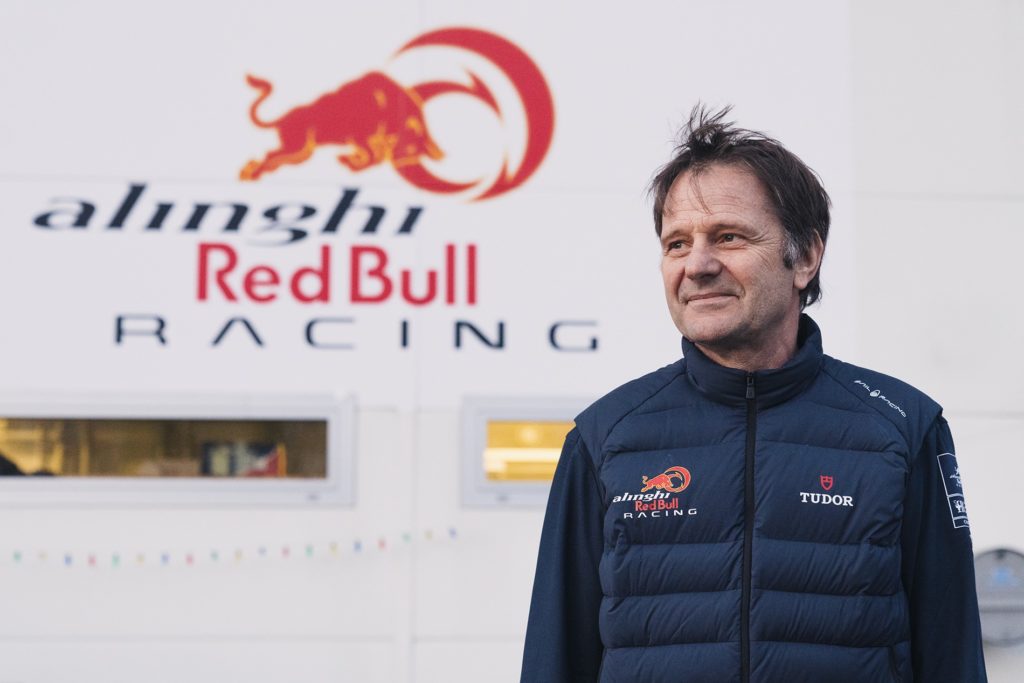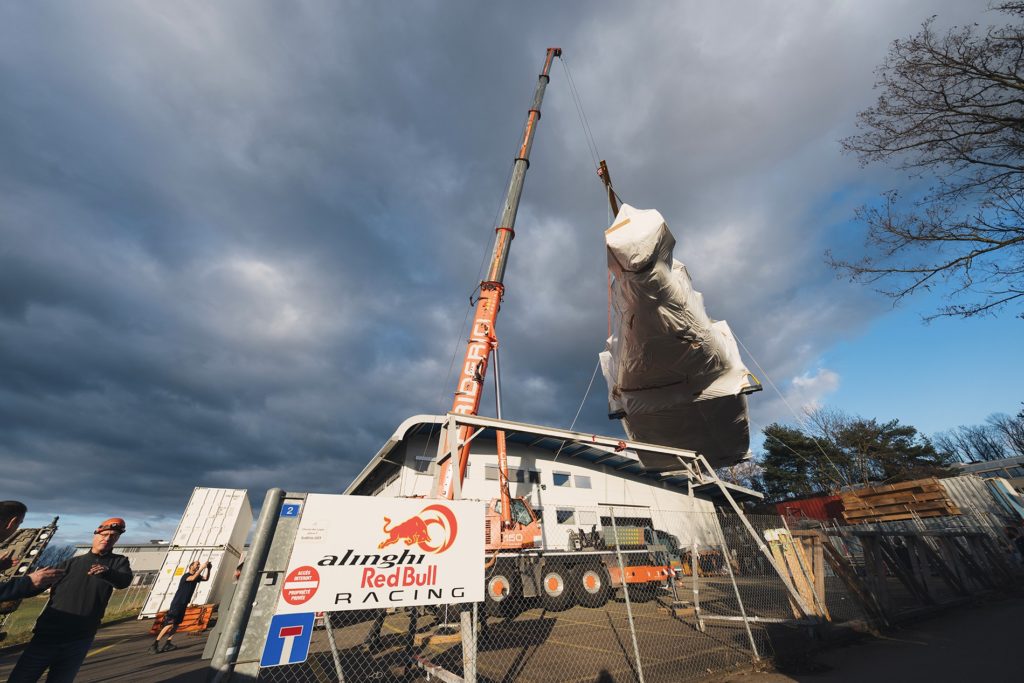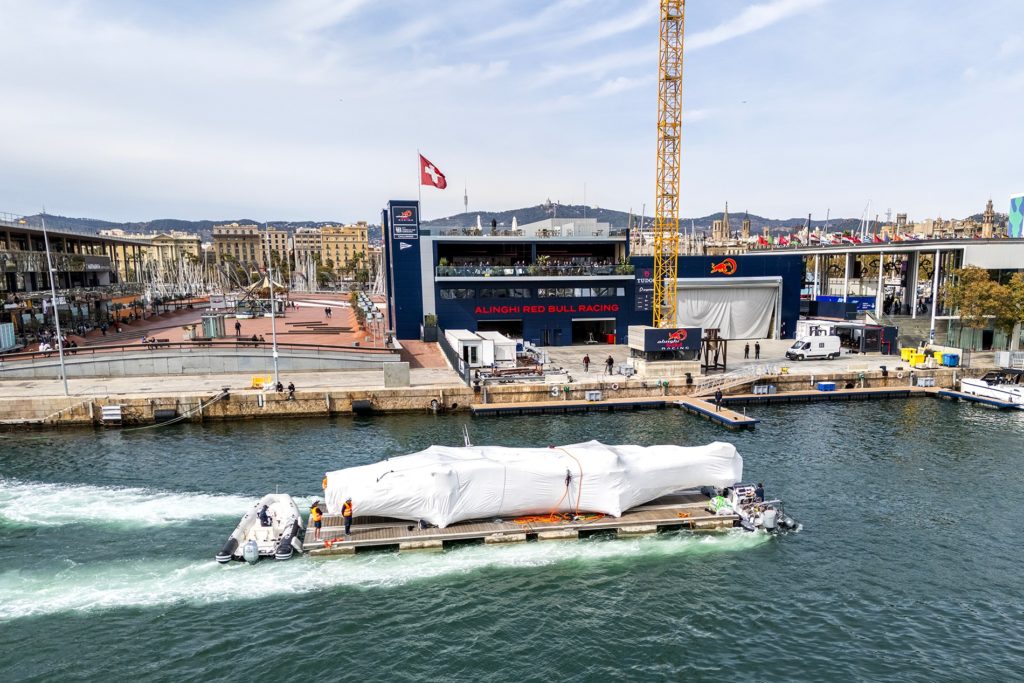Text: Pierre-Antoine Preti
Building a large composite boat is a culinary feat. We met in Ecublens, a few hours after BoatOne’s departure for Barcelona. An emotional moment for Jean-Marie Fragnière, the man in charge of construction. The chef of this three-star kitchen looks back on the technical adventure shared with an extraordinary team of 30 boat builders.

It’s a Thursday afternoon in early March. In the gloom of late winter, Décision SA’s historic shipyard had a festive air. Three days earlier, the huge hull of BoatOne, the only AC75 built by Alinghi Red Bull Racing, was on its way to join BoatZéro in Barcelona. On the heights of Ecublens, some of the 30 boat builders involved in the adventure take their break on the terrace. Now owned by the Swiss team, the former Décision SA shipyard holds no secrets for Jean-Marie Fragnière, who has lived and breathed everything here since the 90s: from Lake Geneva multihulls to Solar Impulse, via Alinghi in the America’s Cup. The construction manager left the company in 2017, to work on the technical set-up of the TF35s. As soon as this job was finished, Jean-Marie received another phone call. A mission not to be refused. He signed on for another two years.
Iterative construction
Started last spring, the construction process is necessarily iterative. The total design of the boat is not yet complete when the process begins. There is constant to-ing and fro-ing between builders, engineers and architects. “At some point, you have to freeze the plans to start building the machines. First the hull is built, then the deck. The interior structures are added, before the deck is closed. Then, using a headlamp, all the parts are welded together, or “grafted”, as we say in the jargon.
The America’s Cup Deed of Gift requires the boat to be “built in the country”. For the 37th edition, the measurement is much more restrictive than a simple “box rule”. Materials are measured. The minimum weight of honeycombs, the rigidity of fibers, the weight of the boat – everything is governed by the Kiwi Defender rule. “We work with the same materials today as we did in 2003, but it’s the way they’re used that has changed a great deal. The gauge allows us to control costs while limiting research and development. On the other hand, the numerous measuring points imposed in the structure mean regular checks throughout the manufacturing process.”
Ten nationalities on site
As always with the America’s Cup, the human resources involved in the project are enormous. It goes far beyond the usual practices in our country. The team is made up of ten nationalities, half of them Swiss. Teamleaders Simon Bovay, David Nikles and Danny Cawsey brought their shipbuilding expertise to the project. There were also two engineers (one to monitor quality and the other to liaise with the Barcelona design team), a full-time CNC operator, a materials cutting specialist and an HR manager, whose responsibilities include ensuring the team’s well-being. Temporary collaborations with other private builders are also part of the team.
As in previous editions, EPFL was on board. Professor Véronique Michaud’s high-performance composites laboratory (LPAC) helped validate and characterize the materials.

A construction site rooted in the Swiss economic fabric
In Switzerland, some thirty SMEs collaborated. Some made molds. These included mechanical workshops, locksmiths, transporters, forwarding agents for customs paperwork…
For Jean-Marie Fragnière, one of the keys to this type of business lies in keeping to the schedule. “All our work is based on the boat’s delivery date, which has been known for two years. We have to adapt to this constraint. Our deadlines are not extensible.”
And yet, some materials take eight months to deliver. It would therefore be fatal to underestimate the order. Sébastien Schmidt is the project manager in charge of planning. He has to acquire all the necessary supplies on time. Coordinating orders and actions is one of the most important aspects of this composite kitchen. It’s a boat builder’s bible.
Cooking: a risky business
Baking is an extremely risky operation. Its success depends on the quality of the vacuum created in the oven, and its airtightness. Each piece requires between three and five passes through the oven. What is relatively simple for small ovens is not necessarily so for larger ones. At Ecublens, the large oven is large enough to fire the entire AC75. Some firings can last up to 16 hours. The evenness of the firing must be monitored. The operation cannot be interrupted. You need a stable, regular power supply throughout the operation. “Last winter, there was talk of quotas and power shortages. We rented a large generator just in case. Fortunately, we didn’t have to use it.
After each baking, there’s the emotion of unmolding. Then there’s the anxiety of checking. On this project, every part of the boat was systematically checked by ultrasound. The enemy here is the porosity of materials and the delamination of fabrics. Nothing was left to chance.


An exceptional convoy
On February 28, the hull left for Barcelona in a special convoy. Under escort, BoatOne travelled for several days. An adventure in itself. With its five-meter width, badly trimmed trees on national roads or urban furniture can sometimes block the passage.
In Ecublens, on the evening of the start, a traffic sign had to be taken down on the first roundabout, a stone’s throw from the construction site.
But the delivery of the AC75 does not mean the end of work in Switzerland. The yard continues to manufacture parts. It is also on stand-by, just in case. The teamleaders and some of the builders will be moving to Barcelona. The Swiss base has been completed. The hull molds remain in Ecublens. In the event of major damage, the two shipyards will work together.
For Jean-Marie Fragnière, the job is far from over. But the head of the construction manager is already full of memories. Probably the most beautiful of these was the first complete assembly of the boat’s hull. An emotional moment! “I’m very proud of this team. The boat builders have been very supportive of each other. I know that with the America’s Cup, it’s difficult to predict the future, but I hope we’ll be able to work with this team again another time… “
But that’s another story! With the delivery of the hull, the boat builders have passed the baton to the sailors. BoatOne is now based in Barcelona. While its technical adventure continues, the specifications look set to be decidedly sporting.

